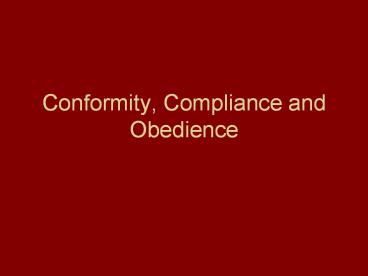Conformity, Compliance and Obedience - PowerPoint PPT Presentation
1 / 15
Title:
Conformity, Compliance and Obedience
Description:
Conformity, Compliance and Obedience What is conformity? A change in behavior/opinion due to real or perceived pressure from others. Stand-out points from ch. 2? – PowerPoint PPT presentation
Number of Views:593
Avg rating:3.0/5.0
Title: Conformity, Compliance and Obedience
1
Conformity, Compliance and Obedience
2
- What is conformity? A change in behavior/opinion
due to real or perceived pressure from others. - Stand-out points from ch. 2?
- Do we see conformity in human service settings?
- Clients as individuals or in groups
- Staff as a group
- Funding decisions
- Policy and procedure discussions
- Consequences?
3
Motivators for conformity
- Consider from both your perspective and the
clients perspective - Reward and punishment
- What might these be in a workplace?
- Need for information
- How might this occur in a workplace?
4
What makes us more likely to conform?
- Unanimity
- Commitment
- Accountability
- The person and the culture s-e as a
professional? Length of time on the job?
Standing in the workplace? - Who are the other people involved?
- Experts, high social status, comparable
- Observe and analyze - http//www.youtube.com/watch
?vOSsPfbup0acfeature
5
Responses to social influence
- Compliance-power
- Reward or punishment driven
- Identification-attractiveness
- Desire to be like the person
- Internalization-credibility
- Congruency with our values.
6
Compliance
- Behavior or attitude lives only as long as the
threat of punishment or the promise of reward is
present. - Doesnt involve much thought about the
behavior/attitude itselfsimply a response.
7
Identification
- Lasting behavior/attitude if I continue to
admire/value/like the person Im conforming to. - May diminish because others become more
important, more desirable. - May diminish because it becomes more important to
me to be right.
8
Internalization
- We take on as our own the belief or the attitude
no longer depends on reward/punishment or the
models influence.
9
- Read the article Mentoring Marines
- In small groups
- Discuss the article and analyze what conditions
might increase conformity. Identify two
examples. - In what ways are compliance, identification and
internalization relevant to this situation? - With what other social problems could we take the
approach described in the article?
10
- Read the article Mentoring Marines
- In small groups
- Discuss the article and analyze what conditions
might increase conformity. Identify two
examples. - In what ways are compliance, identification and
internalization relevant to this situation? - With what other social problems could we take the
approach described in the article?
11
Strategizing
- Brainstorm work situations where conformity may
pose problems. - Youll be assigned a concept develop a short
skit that demonstrates the concept in one of the
work situations. - After the skit, explain whats going on.
12
Letting things gothe Bystander Effect and Social
Problems
- What are some situations in which ordinary people
could take action and reduce a negative outcome? - Violence
- Acquaintance rape
- Interpersonal violence
13
Key factors
- Is this an emergency?
- Is anyone else around?
- Are they getting involved?
- Is there group cohesion?
- Will I see these people later?
- Am I responsible?
- What is the cost to me of getting involved?
- Will I be useful?
- What are the costs/benefits of not helping?
- Do I share a common fate?
14
- SEXUAL VIOLENCE PREVENTION
- THROUGH BYSTANDER
- EDUCATION AN EXPERIMENTAL
- EVALUATION
- Victoria L. Banyard, Mary M. Moynihan, and
- Elizabethe G. Plante
- University of New HampshireJOURNAL OF COMMUNITY
PSYCHOLOGY, Vol. 35, No. 4, 463481 (2007)
15
Study details
- 3 groups, control, 1 session and 3 session
- Intervention included knowledge, role of
bystander, role playing. - Measures included sexual assault knowledge,
rape myth acceptance, efficacy scale, bystander
attitudes, bystander behavior, decisional
balance.































